Something's Fishy: Here comes the sun(fish)
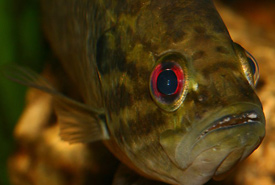
Warmouth up-close (Photo by Clinton & Charles Robertson/Wikimedia Commons)
“We rise when the fish do!” exclaimed my grandfather just as I was settling into the guestroom, known fondly as my room-away-from-home, at my grandparent’s house. “When’s that, grandpa?” I called back in confusion.
“Well, it’s when the sun wakes up,” he answers. So bright and early the following morning a grumpy, sleepy six-year-old and her grandpa piled into a small old boat. It was on that lake where I caught my first fish: a sunfish.
With summer coming to an end, we’re going to be seeing less of the big yellow circle in the sky. What better way to commemorate the large ball of gas known as the sun than to talk about the group of fishes named after it?
Sunfish (sometimes known as panfish) is a term used to describe either a large group of freshwater fish native to North America or a large, deep-bodied marine fish from warm saltwater bodies (known more specifically as ocean sunfish). While there are several different species of fish that fall under this category, a few freshwater species in particular have a special place in my fish-loving heart.
Orangespotted sunfish
This species of sunfish inhabits shallow, muddy creeks in southwestern Ontario. Unlike most sunfish, the male and female orangespotted sunfish are easily distinguishable from one another based on the colour of their spots: males sport orange or red spots, while females don brown ones. The colour of this fish also varies based on their age.
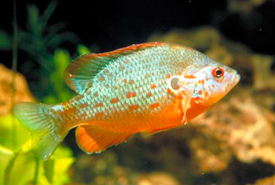
Orangespotted sunfish (Photo by Konrad Schmidt)
Although there are no estimates of the size of Canadian populations of the species, orangespotted sunfish are considered of special concern, according to the Species at Risk Act (SARA). Unlike most fish, the orangespotted sunfish can only live up to five years. Competition for food and predation are considered possible factors impeding the health of this species’ population.
Pumpkinseed
With fall just around the corner, it’s about to be pumpkin everything. Unlike your favourite spiced pumpkin drink, pumpkinseeds are most active from early May to August, during spawning season. During this time, the male will dig a pit in substrate for the eggs to lay in.
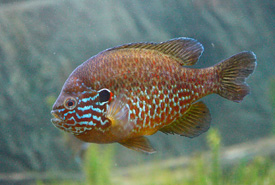
Pumpkinseed (Photo by Aquarium du Quebec)
One of the more brightly coloured sunfish, pumpkinseed, can be identified by the wavy blue-green stripes on its head and orange- or red-spotted ear flaps. They can be found in slow-moving streams across Canada but are native to the Atlantic, except Newfoundland and Labrador.
Green sunfish
In Canada, green sunfish are native to the Great Lakes, Hudson Bay and Mississippi River basins in Ontario. Like most sunfish, this species eats large amounts of plankton during its early years but will switch to aquatic insects, minnows and crayfish later in life.
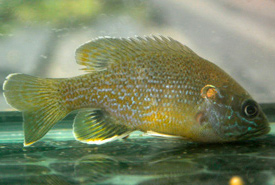
Green sunfish (Photo from Wikimedia Commons)
What sets this species apart from its family members is its tolerance for turbulent water. While most sunfish thrive in clear, cool waters with silt bottoms, green sunfish have no preference and are highly adaptable to waters with rocky bottoms.
Warmouth
Warmouth can be found in similar areas as green sunfish and prefer weedy, slow-moving waterbodies. They have a large mouth extending to or beyond the middle of the eye, with irregular dark, olive-brown bars, similar to rock bass. Easily confused with their red-eyed comrades, you can tell the two apart by their anal fin spines. Warmouth only have three such spines, while rock bass have double the amount of spines on their anal fin.
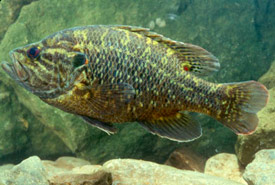
Warmouth (Photo by University of Kentucky)
Warmouth are considered endangered by SARA due to habitat degradation, predication and insufficient food sources. The Nature Conservancy of Canada is working to protect Turkey Point in Norfolk, Ontario, an area along Lake Erie containing warmouth. By limiting habitat damage, NCC is helping sustain the warmouth's population.
Every time I reel in a sunfish, I think about how much I learned from that proverbial Sunday on the lake and every early morning trip out with grandpa afterwards. Every tale has its ending, and eventually so did our fishing trips, but like the sun, my memory of that first catch and grandpa go on shining.
Something’s Fishy is a monthly series written by NCC’s Communications Assistant, Raechel Bonomo, highlighting a species or group of fishes that inhabitant Canadian waters.


